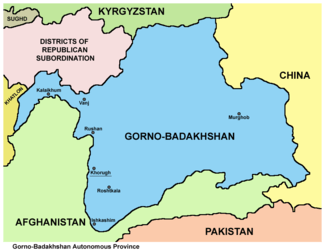Gorno-Badakhshan Autonomous Region
The Kuhistani Badakhshan Autonomous Region (Tajik: Вилояти Мухтори Кӯҳистони Бадахшон, Viloyati Muxtori Köhistoni Badaxshon; also known as Gorno-Badakhshan, /ˈɡɔːrnoʊ bədɑːkˈʃɑːn, -dɑːx-/, after Russian: Горно-Бадахшанская автономная область, romanized: Gorno-Badahšanskaja avtonomnaja oblastj, abbrev. GBAO) is an autonomous region in Eastern Tajikistan. Located in the Pamir Mountains, it makes up 45% of the land area of the country but only 3% of its population.[2]
Gorno-Badakhshan Autonomous Region Вилояти Мухтори Кӯҳистони Бадахшон | |
|---|---|
.jpg) Lake Zorkul | |
 Gorno-Badakhshan in Tajikistan | |
| Country | |
| Capital | Khorugh |
| Government | |
| • Governor | Yodgor Fayzov |
| Area | |
| • Total | 64,200 km2 (24,800 sq mi) |
| Population (2019) | |
| • Total | 226,900 |
| • Density | 3.5/km2 (9.2/sq mi) |
| ISO 3166 code | TJ-GB |
| HDI (2017) | 0.671[1] medium |

History
Prior to 1895, the area of today's Gorno-Badakhshan A.R. consisted of several semi-self governing statelets, including Darwaz, Shughnun-Rushan and Wakhan, who ruled over territories that today are part of Gorno-Badakhshan A.R. in Tajikistan and Badakhshan Province in Afghanistan. The territory was claimed by the Chinese and Russian empires and the Emirate of Afghanistan. The Qing rulers of China claimed control of the entire Pamir Mountains,[3] but Qing military units only controlled the passes just east of Tashkurgan. In the 1890s, the Chinese, Russian and Afghan governments signed a series of agreements that divided Badakhshan, but the Chinese continued to contest these borders, until it signed a 2002 agreement with the government of Tajikistan.[4]
Gorno-Badakhshan Autonomous Region was created in January 1925. It was attached to Tajik Soviet Socialist Republic after the republic's creation in 1929. During the 1950s, the native inhabitants of Gorno-Badakhshan, including many ethnic Pamiris, were forcibly relocated to southwestern Tajikistan. Gorno-Badakhshan absorbed some of the territory of the Gharm Oblast when that territory was dissolved in 1955.
When the civil war broke out in Tajikistan in 1992, the local government in Gorno-Badakhshan declared independence from the Republic of Tajikistan. During the civil war, many Pamiris were targeted for killing by rival groups and Gorno-Badakhshan became a bastion for the opposition. Later the Gorno-Badakhshan government backed down from its calls for independence. Gorno-Badakhshan remains an autonomous region within Tajikistan.[5][6] In 2011, Tajikistan ratified a 1999 deal to cede 1,000 km2 (390 sq mi) of land in the Pamir Mountains to the People's Republic of China, ending a 130-year dispute and the relinquishing of China's claims to over 28,000 km2 (11,000 sq mi) of Tajikistani territory.[7][8]
In 2012, the region saw a series of clashes between the Tajik military and militants loyal to former warlord Tolib Ayombekov after the latter was accused of murdering a Tajik general.[9]
Districts and geography
Darvoz District is the western 'beak' of the province. West-central Gorno-Badakhshan is mostly a series of east-west mountain ranges separated by valleys of rivers that flow into the Panj River. The districts correspond the river valleys. Murghob District occupies the eastern half of the province and is mostly a desolate plateau with high mountains on the west.
- Darvoz District (westernmost, north)
- Vanj District (west, north)
- Rushon District (west, center)
- Shughnon District (west, center)
- Roshtqal'a District (west, south)
- Ishkoshim District (west, southernmost)
- Murghob District (eastern two-thirds)
GBAO covers all the eastern part of the country and borders the Xinjiang Uyghur Autonomous Region of China in the east, the Badakhshan Province of Afghanistan in the south, and Osh Region of Kyrgyzstan in the north. Within Tajikistan the region's western border is with the Districts of Republican Subordination (DRP) and the tip of its south-western finger (Darvoz District) borders on Khatlon Region. The highest mountains are in the Pamirs (ancient Mount Imeon), which is known as the roof of the world, and three of the five 7,000 meter summits in formerly Soviet Central Asia are located here, including Ismoil Somoni Peak (formerly Communism Peak, and, before that, Stalin Peak; 7,495 m), Ibn Sina Peak (formerly Lenin Peak, and still known by that name on its Kyrgyz flank; 7,134 m), on the border with Kyrgyzstan, and Peak Korzhenevskaya (7,105 m).
Demographics
The population of GBAO slightly declined from 206,004 to 205,949 between the censuses in 2000 and 2010. The population as of 2019 is estimated at 226,900.[10] According to the State Statistical Committee of Tajikistan, the main ethnic group in GBAO are Pamiris.[11] The remainder of the population is ethnic Kyrgyz and other nationalities. The largest city in GBAO is Khorugh, population 30,300 (2019 est.);[2] the second largest is Murghab, with about 4,000 residents.
| Mountain | Valley | District |
|---|---|---|
| Darvoz Range | ||
| Vanj River | Vanj District | |
| Sarikol Range | ||
| Murghob District | ||
| Vanj Range | ||
| Yazgulyam River | ||
| Yazgulem Range | ||
| Bartang River | Rushon District | |
| Rushan Range | ||
| Gunt River | Shughnon District | |
| Shughon Range | ||
| Shakhdara River | Roshtqal'a District | |
| Shakhdara Range | ||
| Panj River | Ishkoshim District | |
| Afghanistan | Amu Darya |
GBAO is home to a number of distinct languages and dialects of the Pamir languages group. The Pamiri language speakers represented in Gorno-Badakshan are speakers of Shughni, Rushani, Wakhi, Ishkashimi, Sarikoli, Bartangi, Khufi, Yazgulyam, and Oroshani. Vanji, formerly spoken in the Vanj River valley, became extinct in the 19th century. There is a sizable population of Kyrgyz speakers in the Murghab district. Russian and Tajik are also widely spoken throughout GBAO. The majority religion in GBAO is Ismaili Shi'ite and adherence to the Aga Khan is widespread.[12]
Transport
Only two easily navigable roads connect GBAO to the outside world, Khorog-Osh and Khorog-Dushanbe, both of which are segments of the Pamir Highway. A third road from Khorog to Tashkurgan in China through the Kulma Pass is very rough. Gorno-Badakhshan is separated from Khyber Pakhtunkhwa and Gilgit Baltistan by the narrow, but nearly impassable, Wakhan Corridor. Another road leads from Khorog into the Wakhan and across the Afghan border. Khorog Airport is serviced by Tajik Air and as of 2014 had regularly scheduled flights to Dushanbe.
Energy
In 2019, the European Union and Germany committed 37 million Euros in coordination with the Government of Tajikistan to finance the construction of an 11 MW run-of-the-river hydro power plant along the Shokhdara river. The project is intended to also supply energy to areas of Badakhshan in Afghanistan.[13]
Notable individuals
- Qimmatgul Aliberdiyeva
- Savsan Bandishoeva
- Nobovar Chanorov
- Akbarsho Iskandrov
- Davlat Khudonazarov
- Mirsaid Mirshakar
- Muboraksho Mirzoshoyev
- Qozidavlat Qoimdodov
- Nuqra Rahmatova
- Shodi Shabdolov
- Sabzajon Shoismoilova
- Shirinsho Shotemur
- Khudoyor Yusufbekov
- Gurminj Zavkibekov
See also
References
- "Sub-national HDI - Area Database - Global Data Lab". hdi.globaldatalab.org. Retrieved 13 September 2018.
- Population of the Republic of Tajikistan as of 1 January 2008, State Statistical Committee, Dushanbe, 2008 (in Russian)
- 董丛林. 中国近代史课程教案. Hebei Normal University (in Chinese). Archived from the original on 6 August 2007. Retrieved 2 February 2017.
- "China's Territorial and Boundary Affairs". Ministry of Foreign Affairs, the People's Republic of China. 30 June 2003. Retrieved 27 November 2009.
- Suhrobsho Davlatshoev (2006). "The Formation and Consolidation of Pamiri Ethnic Identity in Tajikistan. Dissertation" (PDF). School of Social Sciences of Middle East Technical University, Turkey (M.S. thesis). Retrieved 25 August 2006.
- "Gorno-Badakhshan Autonomous Oblast (GBAO) :: Regions of Tajikistan". OrexCA.com. Retrieved 2 February 2017.
- "Tajikistan cedes land to China". BBC News. 13 January 2011. Retrieved 3 May 2016.
- "China's area increases by 1000 sq km". Times of India. 12 January 2011. Archived from the original on 16 January 2011. Retrieved 3 May 2016.
- "Tajikistan clashes: 'Many dead' in Gorno-Badakhshan". BBC News. 24 July 2012. Retrieved 25 July 2012.
- Agency on Statistics
- Population census of Tajikistan, 2000 Archived 7 August 2011 at the Wayback Machine on demoscope.ru (in Russian)
- Feygin, Mark (1998). Чужая война (in Russian). Novy Mir. Retrieved 17 June 2017.
- "EU Commits 20 Million Euros for HPP Construction in Tajikistan". Delegation of the European Union to Tajikistan. 6 December 2019. Retrieved 9 December 2018.
- Фоминых, Борис (15 January 2011). Опубликован календарь матчей турнира по хоккею с мячом Азиады-2011 (in Russian). Bandynet. Retrieved 21 February 2015.
Further reading
- Hoeck, Tobias; Droux, Roman; Breu, Thomas; Hurni, Hans; Maselli, Daniel (2007). "Rural energy consumption and land degradation in a post-Soviet setting – an example from the west Pamir mountains in Tajikistan". Energy for Sustainable Development. 11 (1): 48–57. doi:10.1016/S0973-0826(08)60563-3.
- Robinson, Sarah; Guenther, Tanya (2007). "Rural Livelihoods in Three Mountainous Regions of Tajikistan". Post-Communist Economies. 19 (3): 359–378. doi:10.1080/14631370701312352.
- Robinson, Sarah; Whitton, Mark; Biber-Klemm, Susette; Muzofirshoev, Nodaleb (2010). "The Impact of Land-Reform Legislation on Pasture Tenure in Gorno-Badakhshan: From Common Resource to Private Property?". Mountain Research and Development. 30 (1): 4–13. doi:10.1659/MRD-JOURNAL-D-09-00011.1.
External links
| Wikimedia Commons has media related to Gorno-Badakhshan Autonomous Province. |
